What is a Tech Pack?

What Is a Tech Pack?
A Technical Pack, often referred to as a Tech Pack, is a comprehensive production plan for garments that includes all the technical details and design components necessary to produce a unique final product. It enhances the communication between designers and manufacturers and has a big impact on the finished product's quality. In this guide we'll covers the fundamentals of creating a professional Tech Pack, highlighting cutting-edge fashion technology to simplify the entire process.
Curious to see what a professional Tech Pack looks like? Download our free template to get started, or explore our full range of clothing Tech Pack designs for inspiration.
What Is A Tech Pack?
A tech pack is a comprehensive set of illustrations and documents containing every detail needed to produce a garment. It serves as the blueprint for the design.
It enables the designer to communicate with the manufacturer, so they are able to translate what was once a sketch of an idea into reality. It contains very specific details that include flat sketches of the design, colorways, a sizing guide, product measurements, trims and labels, product specifications, and other special instructions.
A detailed clothing tech pack will help the manufacturer have a clear understanding of how to make the specific item. It ensures that the goods are made precisely as designed, in the correct quantity and time it is needed. It minimizes risk for both the manufacturer and the designer by clearly setting out what the desired specifications are for the needed product.
Why is a Tech Pack Important?
A tech pack serves as the communication channel between designers and manufacturers. It functions as a detailed instruction manual for your fashion product, outlining everything the manufacturer needs to know to bring your vision to life. This ensures that everyone involved is on the same page throughout the product creation process. Here's why it's important:
1. A well-constructed tech pack acts as a universal language between the designer and the manufacturer, filling any gaps created by cultural differences, time zones, or even different languages. It clearly conveys the designer's vision, minimizing confusion and ensuring everyone involved is on the same page.
2. The tech pack functions as a shared roadmap, guiding all teams involved in production, from the designer to the manufacturer. This shared document fosters transparency and consistency, keeping everyone aligned with the project's goals.
3. A comprehensive tech pack helps avoid costly mistakes during the sampling creation stage. This saves both time and money, allowing for smoother production and faster delivery of the final product to market. By providing clear specifications, the manufacturer can produce samples that accurately reflect the designer's vision right from the start. Additionally, a clear tech pack enables manufacturers to accurately estimate production costs, ensuring better financial planning for all parties involved.
4. The tech pack serves as a constant reference point for quality control. It allows for easy comparison between the initial design specifications and the actual product at various stages of production. This enables the timely identification and correction of any discrepancies, ensuring the final product meets the desired quality standards.
5. Tech packs can be valuable assets for future collections. By serving as a base template, they allow designers to save time and resources by making adjustments to existing designs, encouraging creativity, and enhancing past designs that have been successful.
What are the Tools Used To Create a Tech Pack?
Even though it's time-consuming, you can create a tech pack by hand using just paper, pens, rulers, and coloring supplies to craft the detailed designs and comprehensive instructions for each creation.The advantage of using freehand drawing is that you don’t need to pay for expensive computer programs to be able to create it, as long as the drawings and instructions are clear. That is the most important thing. The disadvantage is that you have to start every time from scratch.
What is more common and what is considered the industry standard is the use of software programs like Adobe Illustrator or CorelDRAW for the drawings and Microsoft Excel for the specs and worksheets.
There are also tech pack templates that can be purchased online like FittDesign's ready templates that will help you organize the tech pack and make it easier for you not to miss out on any of the details needed. Templates are great because you can simply reuse them for new projects and avoid having to recreate a tech pack from scratch. Either way, the most important thing is to remember that it has to include everything necessary for the manufacturer to be able to interpret the designer’s idea to produce the garment.
What's Inside A Tech Pack?
Every brand or company has its own checklist when it comes to making tech packs. Some are more detailed than others. While it is good to be as detailed as possible, there are a few essential components that are standard and should not be missed.
▪️Garment Illustration and Colorway Schedule
The most basic part of the tech pack is the drawings. This represents the idea in visual form. It is important to have a colored illustration to see what the garment will look like when done. This will show the color of the main fabric, secondary fabric combination, and embroidery or print details scaled to size. This should also give a general idea of what the garment’s front and back views look like. Sometimes, if the garment is more complicated, it will also be helpful to show the side view.
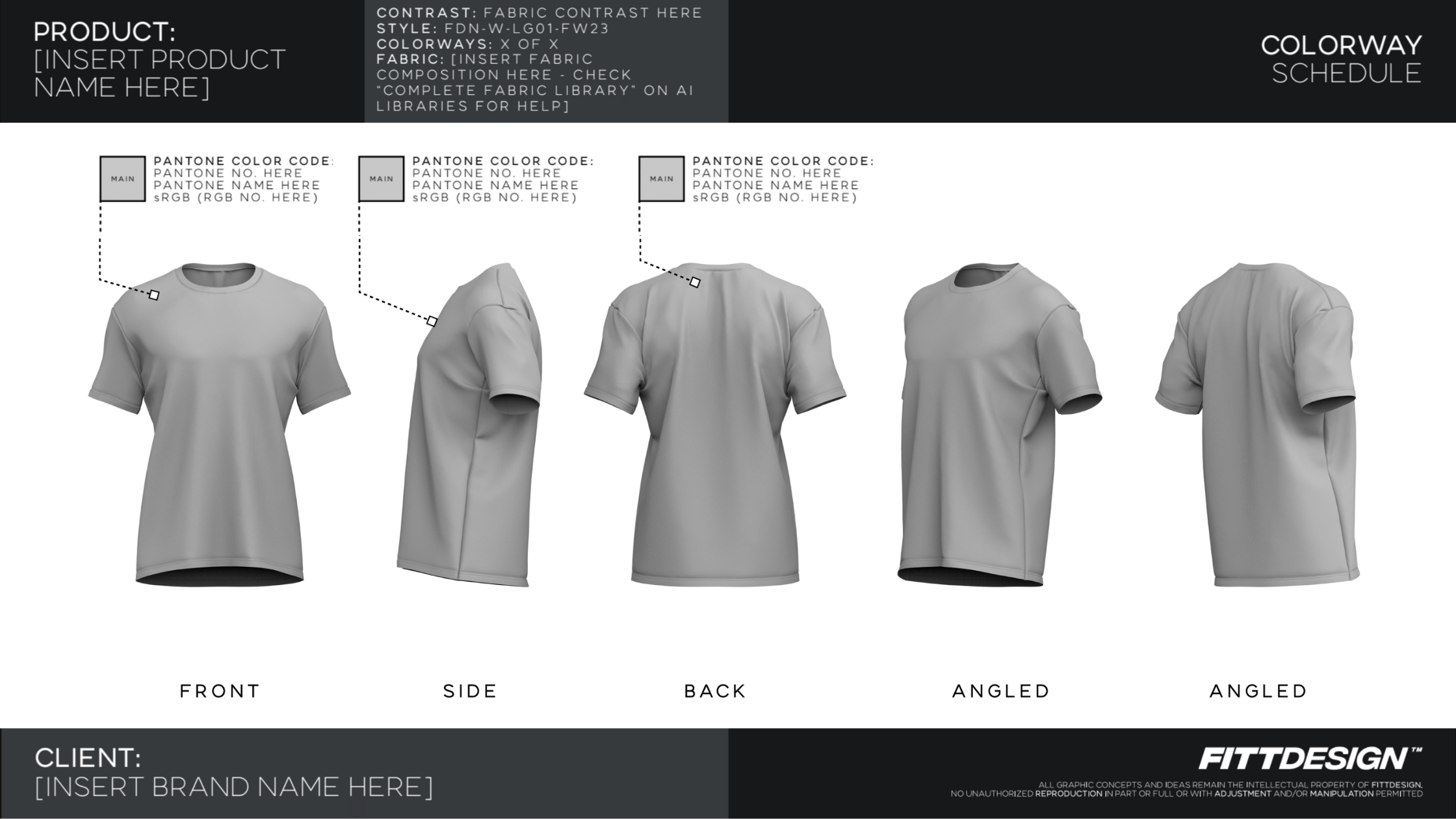
It should also include a technical black-and-white drawing that shows the garment's construction. This page will include the kinds of stitches and the general silhouette; it should describe the placement of fabric combinations and trims, patches, and appliques if there are any. It can also include details of the thickness of the thread to use, SPI (Stitch per Inch), and detailed descriptions of parts of the garment that need to be highlighted. If the garment has a fake welt pocket at the left panel, it should clearly state so. Always remember that details like these can affect the cost of the garment as well.
In most cases, one design comes in more than one color. If this is the case, then the colorways, including color combinations of fabric, thread, and sundries, should be shown so the factory is aware of how many kinds they are working on for one design.
Details to Include:
3D Models or Flats: 3D realistic representations.
Multiple Angles: Front, back, side, and any unique views (e.g., top-down for hoods).
Color Blocks: Indicate different materials and their Pantone colors.
Fabric Details: Composition, weight (GSM), and weave type.
Trims: Types of zippers, drawstring materials, and finishes.
Color Codes: Use Pantone or another standardized system for accuracy.
▪️Point Of Measurements and Sizing Guide
Include a detailed sizing chart with key points of measurement. This helps manufacturers understand how to size the garment correctly. Indicate whether measurements are taken with the garment laid flat or worn.
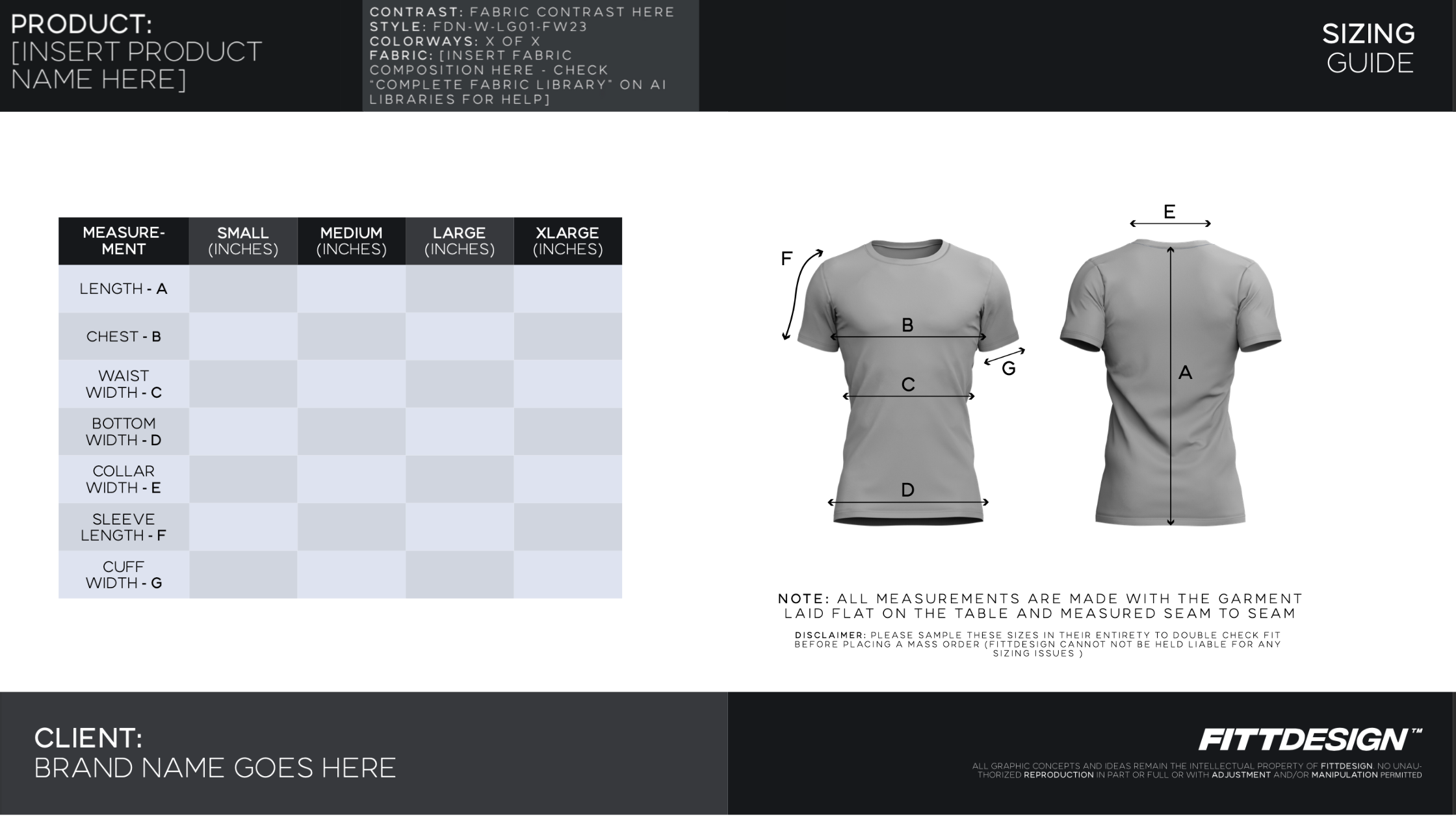
The tech pack should include the size specifications of the design. Bigger factories that are more established already have pattern blocks that can be used if none are available. The specs should indicate the sample size and should also include the graded specs once they are available.
Points of Measurement, or POMs, are a set of guidelines to make sure that whoever is measuring the garment will be measuring on the same spots as specified in the guidelines. This ensures an apple-to-apple comparison for quality checks.
The important thing to consider is that you and your manufacturer should be measuring the garment the same way to avoid confusion.
Details to Include:
Points of Measurement: Bust, waist, hip, sleeve length, etc.
Size Variations: Provide increments for different sizes (e.g., S, M, L).
Measurement Method: Specify flat or worn measurements.
▪️Technical Sheet
The technical sheet is one of the most crucial parts of a tech pack. It provides a technical flat of the garment, which is a detailed drawing showing the garment laid out flat, highlighting all critical measurements and construction details
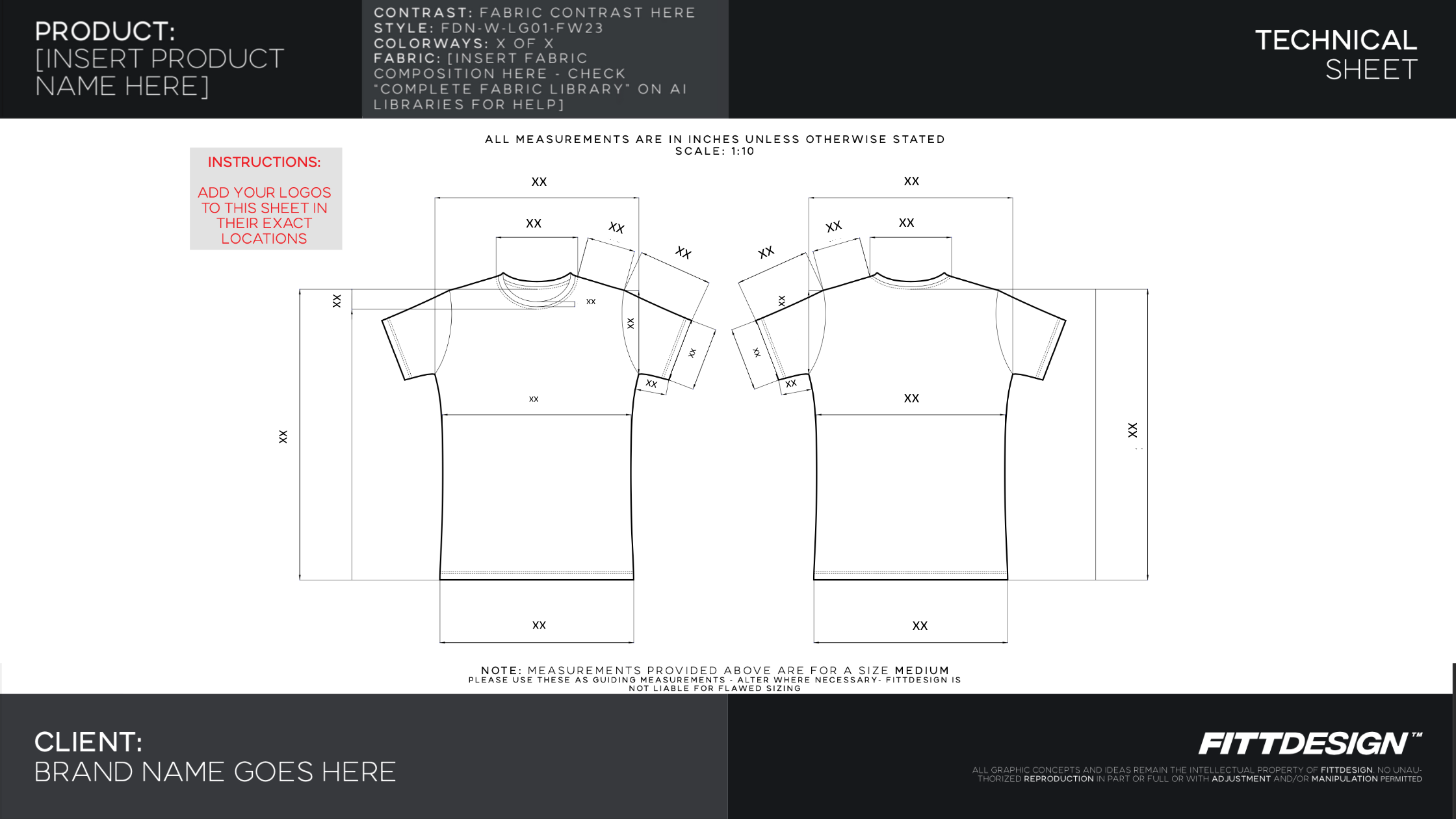
It includes pocket sizes, zipper lengths, waistband heights, seam placements, and any unique features or trims. The technical sheet ensures that pattern makers have all the necessary information to create the garment accurately.
Details to Include:
Flat Sketches: Detailed views of the garment laid flat.
Measurements: Exact dimensions for all parts, including pockets, zippers, cuffs, and waistband.
Seam Details: Type and placement of seams (e.g., overlock, topstitch).
Construction Notes: Details on stitch type, seam allowances, and any special construction techniques.
▪️Garment Specifications sheet
On the garment specs sheet, you will find all the details about the fabric, lining, combination fabrics, trims and sundries, thread color and thickness, sewing and packing labels, or trim card. Information about consumption and the suppliers, if available, is also helpful to mention here. If a printed copy of the tech pack is sent to the manufacturer, it will be best to include cut swatches of actual fabrics or a representative of something similar, a sample of buttons, closures, etc.
The garment specs will give you an overview of what raw materials were used to create the garment.
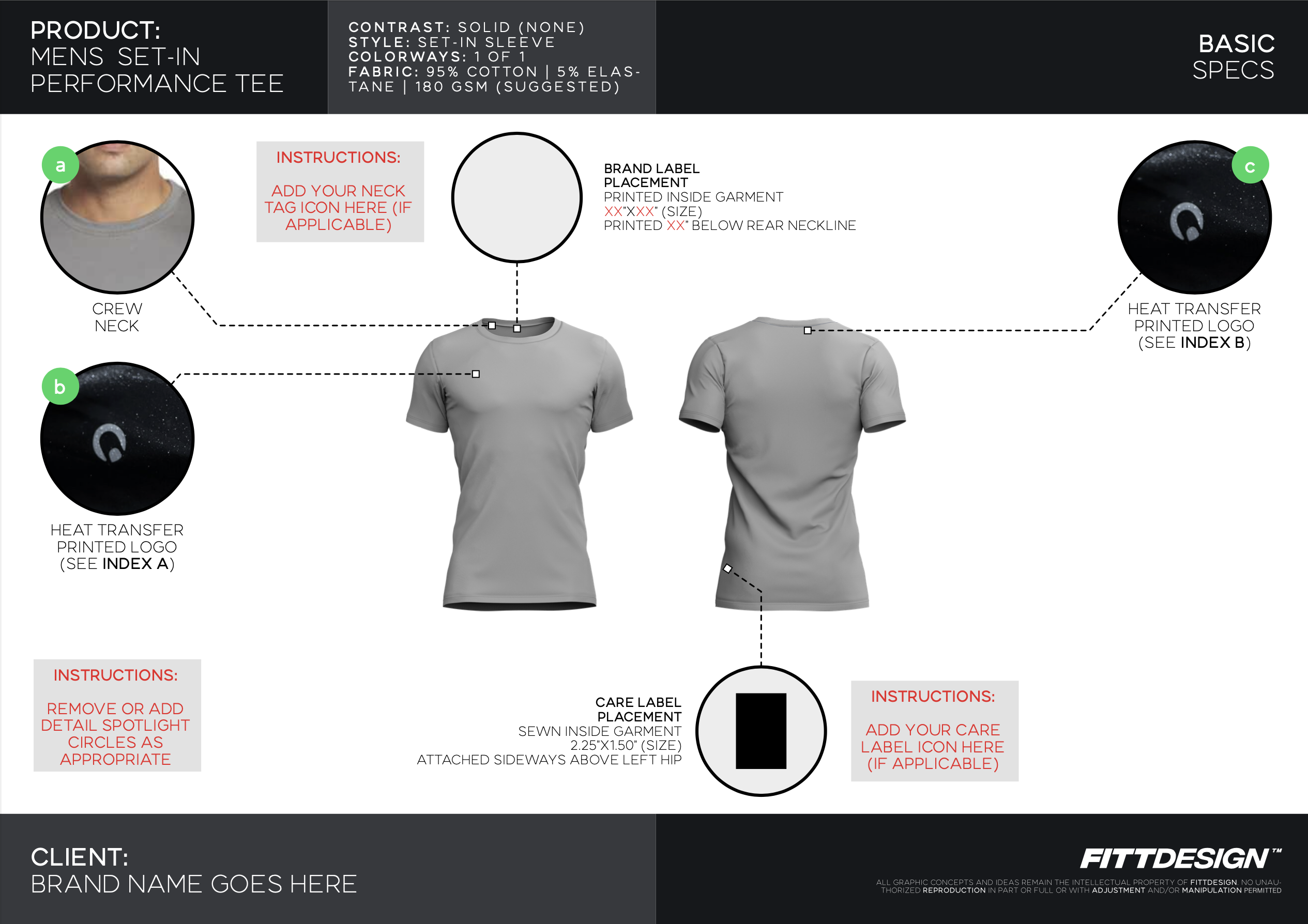
List any additional details, such as waistband construction, drawstring types, and zipper pullers. Include visual references to showcase these elements. Specify the materials and construction methods for trims and notions.
Details to Include:
Waistband: Type (elastic, ribbed), height, and construction method.
Drawstrings: Material, color, and type of aglets.
Zippers: Type (coil, metal), length, and color.
Branding Elements
Showcase all branding elements, such as logos and graphics. Provide vector files and specify the exact placement and size of each element on the garment to ensure accuracy during production.
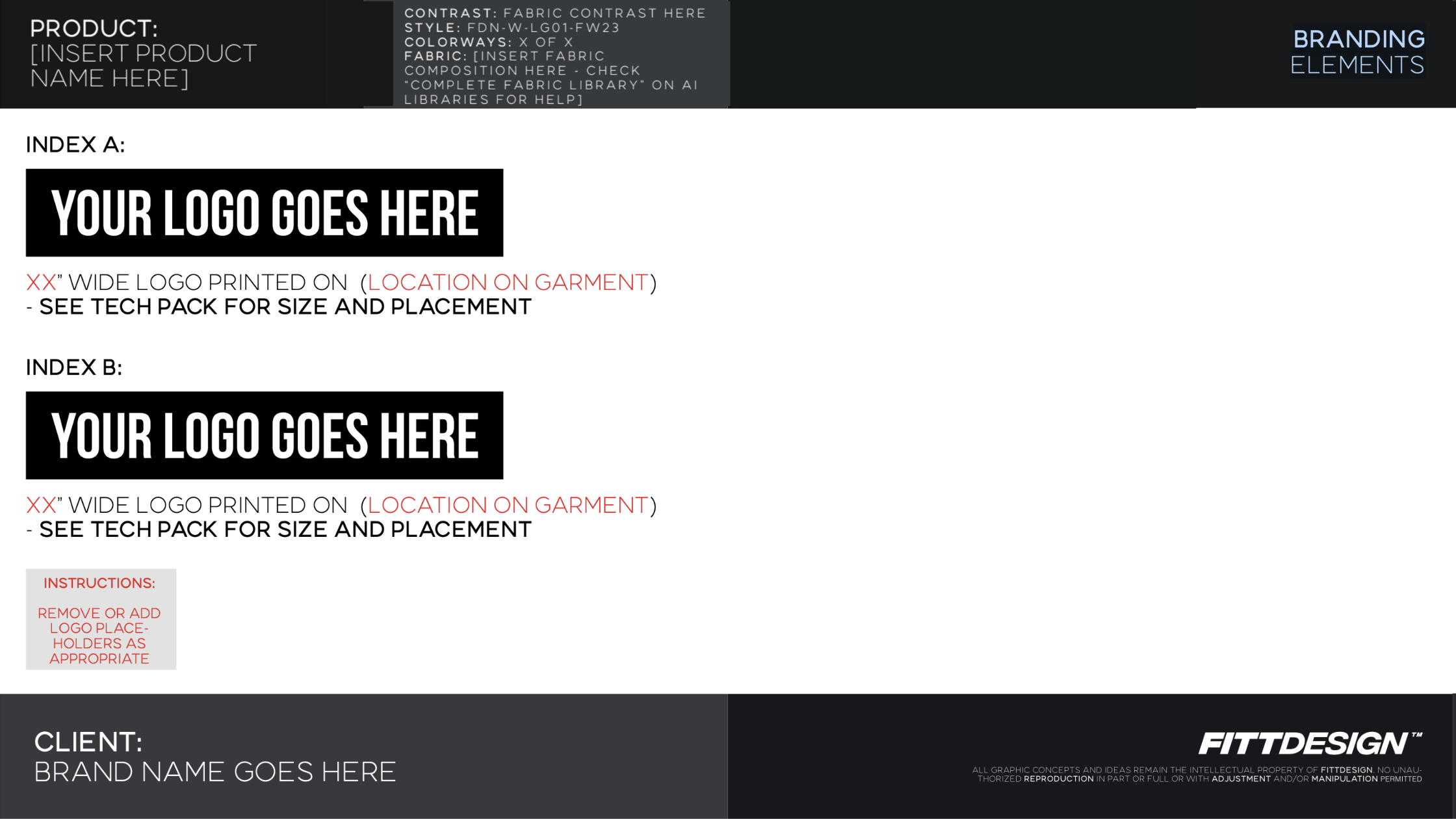
Details to Include:
Logos: Vector files, size, and placement.
Graphics: Detailed designs and exact positions.
Measurements: Distances from key reference points (e.g., seam lines).
Color Swatches
If the design comes in multiple colorways, provide a table that lists all the different combinations. This helps manufacturers know how much of each color is needed for production.
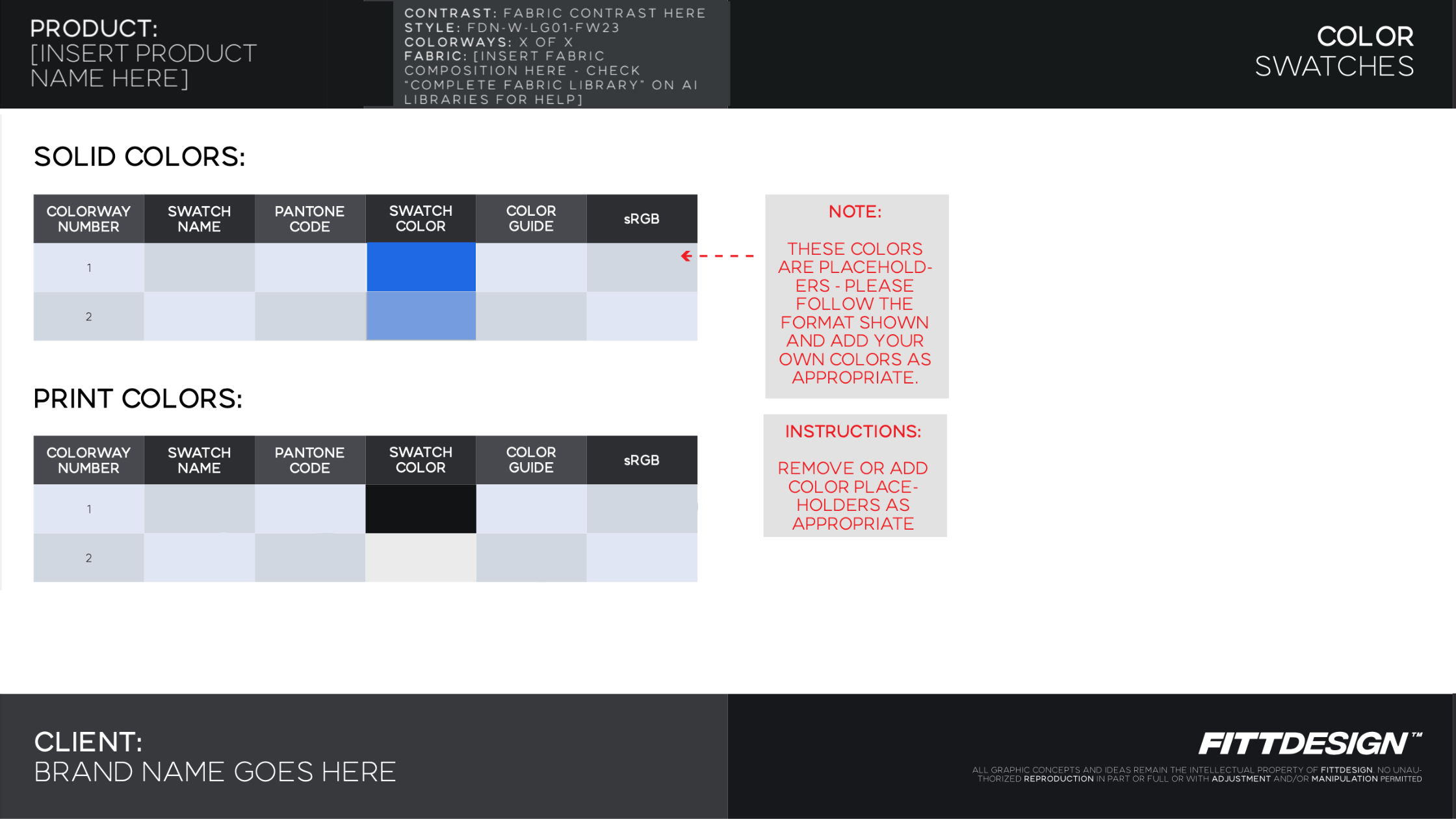
Details to Include:
Main Fabric Colors: Primary colors for the garment.
Accent Colors: For trims, logos, and additional details.
Combinations: List of all possible colorways.
Packaging and Labels
Describe the packaging and labeling requirements. Include details about care labels, size tags, and any other necessary labels. Provide visual references for these elements and specify their placement on the garment.
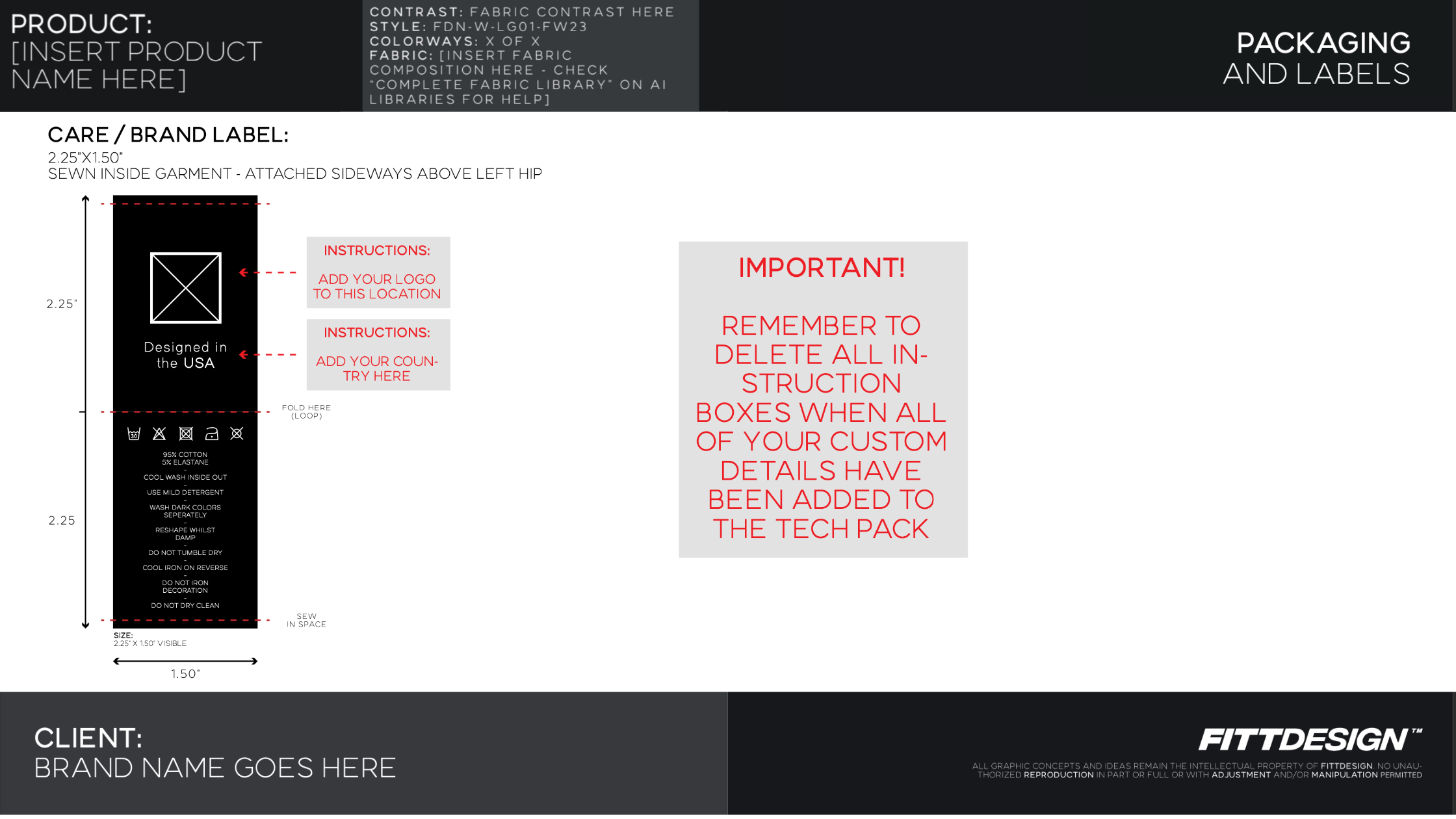
Details to Include:
Care Labels: Material, size, and placement.
Size Tags: Design, material, and attachment method.
Packaging: Type of packaging, materials used, and branding.
▪️Worksheet
The worksheet is a tracking sheet that helps you log all the activities that transpire in the course of development to production. It will ensure that deadlines are met and schedules are on track. This should include dates of sending and receiving samples, comments, and revisions, any changes that might arise, amendments to previous agreements, and other significant movements that will affect the progress of the development or production.
▪️Costing Sheet
Some tech packs include the costing sheet. It includes the CTP or the cost to produce the garment. If you are sourcing the suppliers of the raw materials and the manufacturer separately, it is important to keep track of the spending cost per garment to make sure that you are within your acceptable budgeted allowance.
"Take note that this is an internal document and contains information that should be seen only by authorized people."
Key Points
There are many ways to create a tech pack, but its function remains the same. It should be able to clearly communicate to the manufacturer what the designer has envisioned, so they can make the vision a tangible product.The best way to test if the tech pack has been done properly is if the first sample comes out with very minimal revisions.
In truth, creating a tech pack is time-consuming. It is a very tedious task due to the amount of details needed to complete and organize it. However, when you see its value, all the effort pays off in the end
Tech Pack examples
Now that you’ve learned all about how to make a tech pack, here are some examples of detailed Tech Packs for t-shirts, hoodies, joggers, leggings, etc., made by FittDesign.
Check out our templates section for a wide selection of apparel design tech packs.
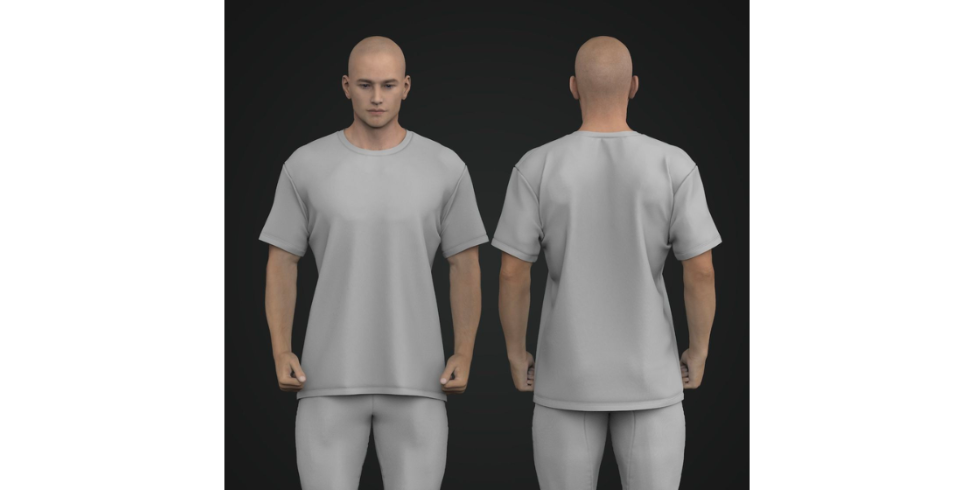
MENS OVERSIZED DROPPED SHOULDER T-SHIRT
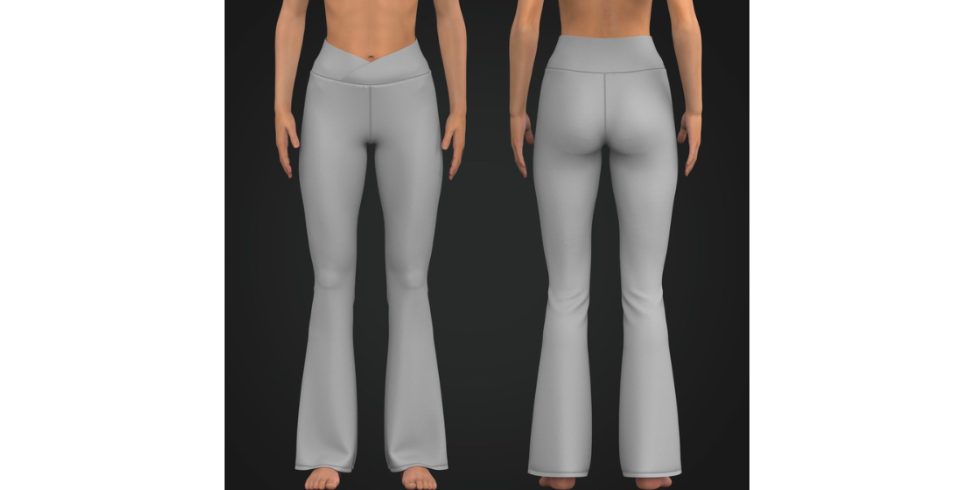
LADIES CROSS OVER HIGH-WAISTED FLARED LEGGINGS
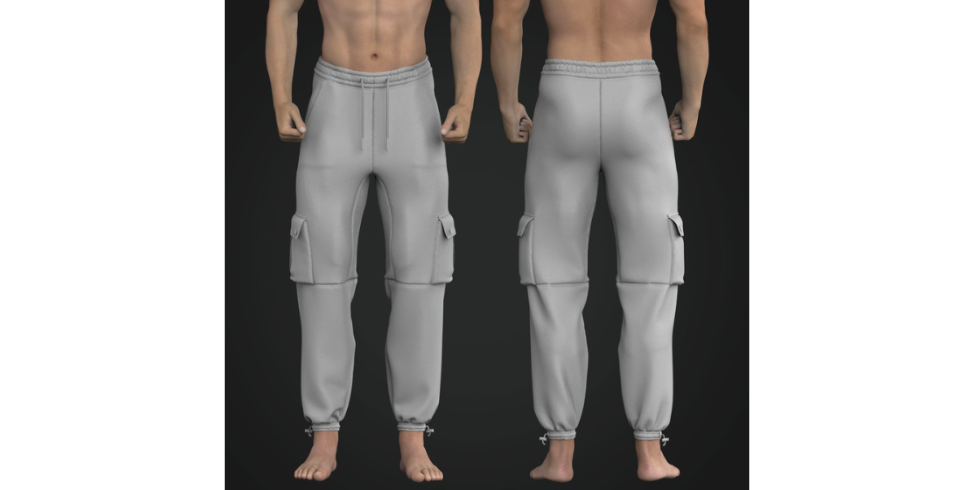
MENS ELASTIC CUFF WOVEN CARGO JOGGERS
At FittDesign, we offer customized Tech pack services tailored to your unique vision. We're here to bring your ideas to life with precision and style. And if you're looking for ready-made tech packs, visit our website to explore our extensive collection. Contact us for custom tech packs or browse our ready-made options now!
About FittDesign
FittDesign is a full-service design and production company specializing in the sportswear and activewear industry. We provide comprehensive solutions including innovative design, detailed technical packs, and high-quality manufacturing. Our expertise supports brands in creating functional and durable sportswear that meets the demands of a competitive market.
Ready to Bring Your Activewear Vision to Life?
Contact Us today and let’s get started on your project!
